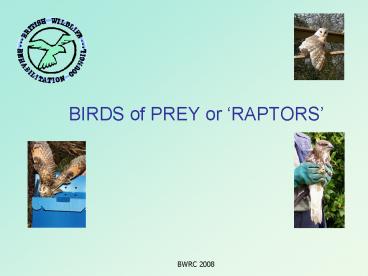BIRDS of PREY or RAPTORS PowerPoint PPT Presentation
1 / 19
Title: BIRDS of PREY or RAPTORS
1
BIRDS of PREY or RAPTORS
2
CONTENT
- Identification natural history
- Human influences on populations
- Common situations leading to rescue
3
What is a RAPTOR?
- The terms bird of prey or raptor describe
birds which generally have - a hooked beak
- talons
- All of these birds catch prey with their feet,
except vultures, which are generally scavengers.
4
UK Residents
- Accipitridae (hawks)
- common buzzard, sparrowhawk, goshawk, hen
harrier, marsh harrier, red kite and golden
eagle. - Falconidae (falcons)
- kestrel, peregrine, hobby merlin
- Strigidae (owls)
- tawny, little, long-eared short-eared owls
- Tytonidae (barn owls)
- barn owl
5
Human Influences On Populations (1)
- Raptors traditionally regarded as pests of young
game birds - Control by gamekeepers during the 1800s
severely reduced several UK species - Poisoning of birds of prey outlawed by 1911
Protection of Animals Act further protection
under Protection of Birds Act (1954) - Dramatic decline in raptor populations in 50s
60s - led to voluntary ban on organochlorine
pesticides in UK
6
Human Influences On Populations (2)
- Increased popularity of falconry in Europe and
the USA led to - theft of eggs and young birds from the wild
- development of breeding programmes by falconers
during the 1970s - Some wild populations fully recovered from the
pesticide crisis but illegal persecution
continues - Successful reintroduction programmes
havere-established the European goshawk
(Accipiter gentilis) and red kite (Milvus milvus)
in the UK.
7
Raptors and rehabilitation
- Species commonly encountered by rehabilitators
- Tawny owl (Strix aluco)
- Kestrel (Falco tinnunculus)
- Sparrowhawk (Accipiter nisus)
- Buzzard (Buteo buteo)
- Barn owl (Tyto alba)
- Little owl (Athene noctua)
8
Hawks and falcons
Kestrel (Falco tinnunculus)
Sparrowhawk (Accipiter nisus)
Buzzard (Buteo buteo)
9
Owls
Barn owl (Tyto alba)
Tawny owl (Strix aluco)
Little owl (Athene noctua)
10
Most common casualty species rescued by Raptor
Rescue(2000-2006)
11
Common SituationsLeading To Rescue
12
Common SituationsLeading To Rescue
13
Common SituationsLeading To Rescue
14
Common SituationsLeading To Rescue
15
Causes of incapacity recorded by Raptor Rescue
during 2003-05
16
Causes of incapacity recorded by Raptor Rescue
during 2003-05
- Unnatural causes' of injuries would include the
following - burns from fire or chemicals
- entanglements and ligatures around body parts
- collision with overhead lines or windows
- shooting
- Other' category includes
- bird has taken up residence where it is in
danger/not wanted - member of the public hands in a healthy bird and
refuses to take it back - an imprinted bird
- an unwanted captive-bred bird for re-homing
17
Causes of incapacity recorded by Raptor Rescue
during 2003-05
- Human activity accounts for 53 of casualties
from this sample - (not including natural causes, abandoned birds
and the Other category). - Road traffic accidents are the greatest single
cause of raptor casualties (27.5) directly
related to human activity
18
SUMMARY
- Raptor populations have been (and some still
are) severely affected by farming and
game-keeping - Several species are now being reintroduced into
the UK - Rehabilitators commonly encounter 6 species
- (tawny owls are the most common casualties)
- Natural causes and RTAs are common situations
leading to rescue of raptors - Tawny owl chicks in particular are often mistaken
for orphans by the general public
19
Acknowledgements
- With thanks to Christine Shaw Thomson and Ian
Taylor of Raptor Rescue (Reg. Charity 283733) for
providing their casualty statistics

